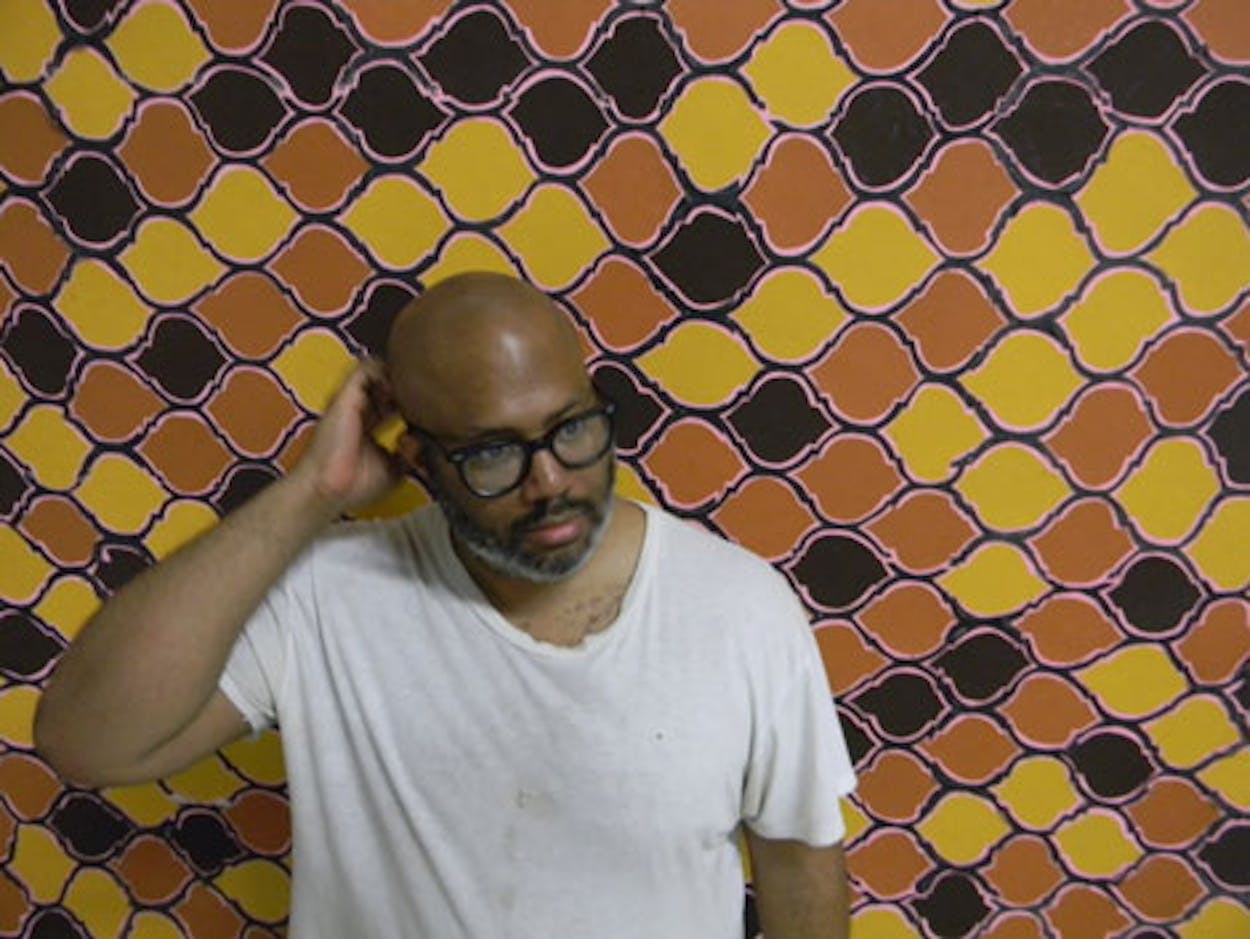Trenton Doyle Hancock stood at the back of his art studio, a warehouse space in the Acres Homes neighborhood that is filled with piles of cut-up paintings that he has been recycling since his career began twelve years ago.
He was looking at one of his new works, “The Den,” an 11-by-7-foot brown, orange and yellow honeycomb-pattern collage painting that appears to breathe, as if the viewer is hallucinating. It is the anchor piece for Hancock’s “. . . And Then It All Came Back To Me,” the first New York solo exhibition since 2008 for the 38-year-old rising star in the American contemporary-art world. It opens November 1 at the James Cohan Gallery.
“This one in a way told me what I needed to do to these other ones,” said Hancock, dressed in an undershirt, sweatpants, and a pair of Adidas. “It’s not like anything else I’ve ever done.”
Anyone who is familiar with Hancock’s critically and commercially successful “Mounds” and “Vegans” series would agree that “The Den,” with its straight-laced design of lemon-shaped pieces of paper layered onto canvas, is a major departure for the Houston-based artist whose work is on display at Cowboys Stadium and was included in the 2000 and 2002 Whitney Biennials.
When Hancock attended Temple University’s Tyler School of Art, he created an imaginary universe populated by “Mounds,” half-human, half-plant beings who “represent the Earth and stability,” and “Vegans,” who “as a mob are unleashed to upset that stability.” The comic book-style outsider-art hallmarks of this series—including bloodshot eyes, oversized brutish feet, cryptic text—elicited comparisons to Henry Darger and Philip Guston and the ongoing saga has defined much of Hancock’s career.
But he now feels the storyline is starting to distract from the artistry. “The whole reason I did it to begin with was so I had this constant script, if you will, to react against,” Hancock said. “And now it’s like, well, the script is my life.”
This new period is eagerly anticipated by curators, critics and collectors, whose buzz has made the exhibition one of Artinfo’s 40 Most Anticipated New York Fall Gallery Shows.
“When Trenton was first developing his narrative in graduate school, he was playing with the notion of how, as an African-American artist, it would be possible to emerge from the shadow of Jean-Michel Basquiat,” said James Cohan, who approached Hancock in 2000 upon artist Fred Tomaselli’s recommendation. “The narrative became a vehicle to address both personal and social issues through the lens of parable,” Cohan added by email. “Now he’s moving beyond this framework to more directly explore his persona.”
Hancock’s artistic transformation began early last year, when he was giving a lecture at Cornell University. While using the bathroom at a graduate student’s house, he noticed that the floor was the same tile that his grandmother had in her house in Paris, the town in northeast Texas where he grew up.
“I thought, this tile is going to somehow show up in my work,” Hancock said. “Because there’s no reason I should be a thousand miles away from home, in this dude’s bathroom, and see this. I believe things are gifted to you or put in your path to notice, and this was a big one.”
That tile inspired “The Den.” The restraint exercised on the painting makes it singular, but its personal tone can be found in other pieces in this collection. Out of these thirty new works, many still retain Hancock’s grotesque eccentricities and savant-like detail, whether in wildly exaggerated self-portraits or large-scale abstract-expressionist pieces.
“Trenton is an artist who completely inhabits his images, and who has a rare capacity for engaging a repertoire of forms and motifs to develop a seemingly endless series of variations on a profound core idea,” Lawrence Rinder, curator of the 2002 Whitney Biennial, wrote in an email.
Hancock pointed to a painting in his studio that featured muddy-white bone-like pieces entangled like wayward plumbing inside of a circular black mass. Lemon-colored and -shaped pieces of canvas, similar to the ones in “The Den,” embellished the perimeter, but these shapes are influenced by something different: a yellow toy he had in the studio called a Keepon, used to help autistic children interact. The yellow framing the black reminded Hancock of a beehive, which in turn made him think of his stepfather, Thomas Johnson, who died in 2010.
“One of his sayings was, ‘Keep on keeping on,’” Hancock said. “Keepon. Keep on keeping on. Beekeeper. My step-dad started a restaurant called the Honey Bee. I’m like, oh, this painting is called ‘Kept on Keeping On.’”
Hancock described his stepfather as a “Southern Baptist, fire and brimstone, small town Texas minister” who was also a black-belt karate instructor, a carpenter who “built half the houses in Paris,” and a plant worker at Campbell’s Soup, where he worked nights for forty years without missing a single shift. His industrious nature is reflected in Hancock’s prolific output.
His stepfather’s death came close to that of his other grandmother and to a divorce from his wife, a series of circumstances that gave Hancock renewed purpose. With “The Den,” he has taken a step back in order to take a step forward, creating his most “boring” yet “profound” painting.
“I’m returning to the self and the limitations of my own body and my own autobiography,” Hancock said. “This is about my family.”







